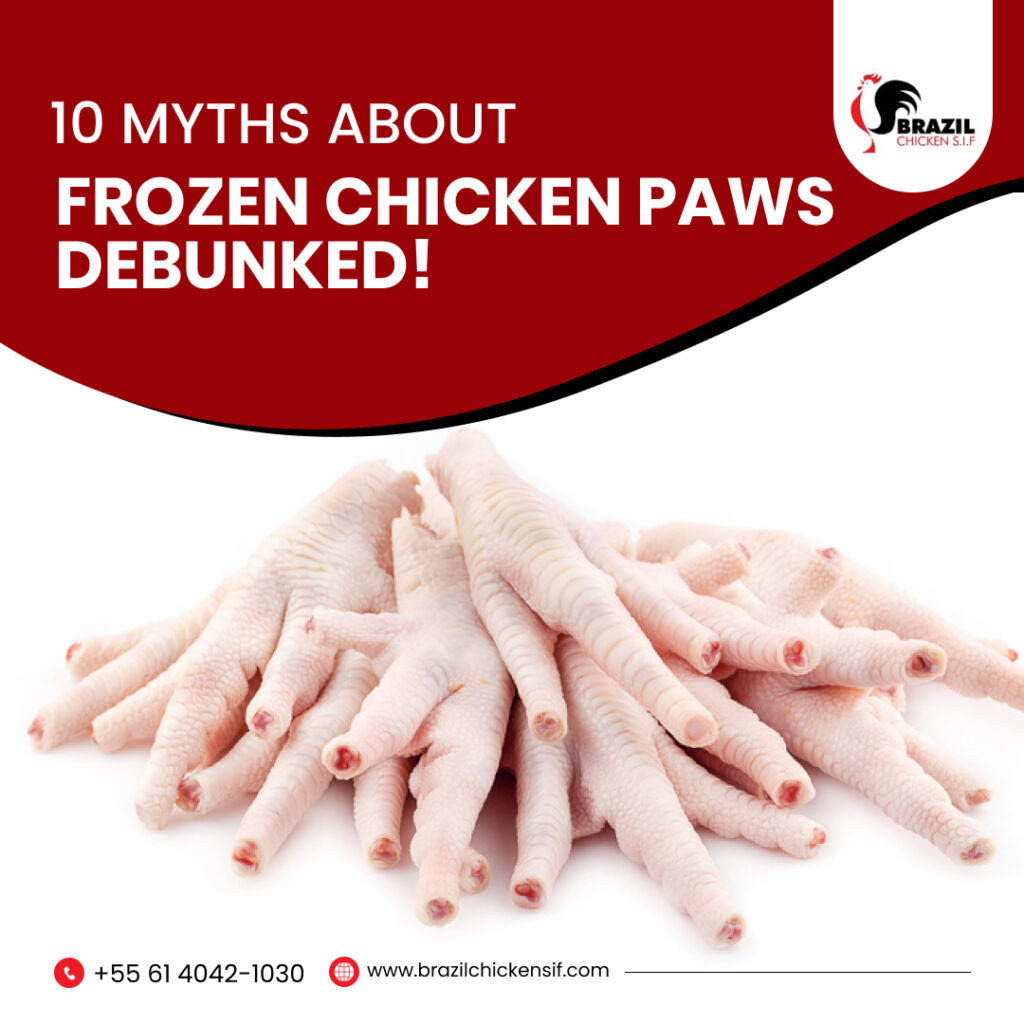Due to their taste, affordability, and simplicity of storage, frozen chicken paws are a preferred option in many homes and restaurants. However, there are numerous myths about frozen chicken paws that cause misunderstandings and disinformation. We hope to dispel 10 prevalent fallacies about frozen chicken paws in this post so that you may choose wisely when adding them to your dishes.
So, let’s check out these myths and the actual truth behind them.

Top 10 Myths About Frozen Chicken Paws
Find out the truths behind the different myths that surround frozen chicken paws and deter people from buying them.
Myth 1: It’s Not Healthy to Eat Frozen Chicken Paws
It’s not necessarily unhealthy to eat frozen chicken paws. Their nutritional worth depends on how they are prepared and cooked, just like it does with other food products. Frozen chicken paws can be a source of protein, vitamins, and minerals when prepared and eaten moderately as part of a balanced diet.
Myth 2: Fresh Chicken Paws Are Healthier Than Frozen Chicken Paws
When at their freshest, frozen chicken paws are frequently flash-frozen to maintain their nutritional content. In fact, fresh chicken paws, which may have been sitting in the market for days, are occasionally even more nutrient-dense than frozen ones.
Myth 3: Harmful Preservatives Are Included in Frozen Chicken Paws
The majority of frozen chicken paws sold in stores don’t include any dangerous preservatives. By itself, freezing serves as a natural preservative, preserving the product’s quality and flavor over time. If you are concerned, always read the product label to look for additives.
Myth 4: Frozen Chicken Paws Are Chemical-filled
Usually, minimal amounts of chemical additives are not required during the processing and freezing of frozen chicken paws. But if you want something more natural, it’s important to study labels and pick items with few ingredients.
Myth 5: Chicken Paws From Frozen Chickens Are Poor-Quality Meat
Where the chicken is raised and how the supplier is supplying the meat both affect the quality of frozen chicken paws. A good and satisfying dining experience is provided by reputable brands that make sure their frozen chicken paws match quality criteria.
Myth 6: Canned or Frozen Chicken Paws Lack Flavor
When properly prepared, frozen chicken paws can have a flavor that are better than fresh ones. They can be a delightful complement to your meals by marinating, seasoning, and carefully grilling them to improve their flavor and texture.
Myth 7: Only Deep-Frying Chicken Paws That Have Been Frozen Are Appropriate
While deep-frying is a common way to prepare chicken paws, it’s not the only choice. Additionally, you could bake, broil, stir-fry, or even include them in stews and soups. Trying out various cooking techniques can provide delicious results.
Myth 8: All Frozen Chicken Paws Are the Same
There are various varieties of frozen chicken paws. The flavor and quality of the finished product can be affected by elements including the breed of the chicken, its food, and the processing techniques. To choose the best brand meets your interests, so make sure you choose the online portal from where you will place the order correctly.
Myth 9: It’s Not Safe to Eat Frozen Chicken Paws
Frozen chicken paws can be consumed safely if handled, stored, and prepared correctly. To reduce your risk of contracting a foodborne illness, always abide by food safety regulations.
Myth 10: Frozen Chicken Paws Are Only Appropriate for Special Occasions
Frozen chicken paws can be used for both regular dinners and exceptional events. They are a practical option for any culinary expedition due to their low cost and lengthy shelf life.
Tips for Choosing and Cooking Frozen Chicken Paws
Having dispelled these widespread misconceptions, the following advice is provided for selecting and preparing frozen chicken paws:
- Look at the Label: Choose products with the least amount of processing and look at the product label for any additives or preservatives.
- Thaw Correctly: Make sure to thaw the frozen chicken paws in the fridge and let them defrost safely to avoid bacterial growth. A room-temperature thaw should be avoided.
- Season and Marinate: Before cooking, marinate frozen chicken paws in your preferred spices and herbs to enhance their flavor.
- Experiment with Different Cooking Methods: To find your best method of cooking frozen chicken paws, experiment with a variety of cooking techniques, such as baking, grilling, or stir-frying.
- Watch the Cooking Time: Do not overcook frozen chicken paws because the meat may become tough and dry. Observe the suggested cooking temperatures and times.
- Cook with Complementary Ingredients: Consider serving frozen chicken paws with vegetables, rice, or pasta for a balanced meal. Pair with complementary ingredients.
Take away
In summary, frozen chicken paws are a practical and wholesome protein source that can be a useful complement to your cooking skills. You may eat wonderful meals that contain frozen chicken paws with no reservations by busting these myths and using the right cooking and handling methods. So go ahead and investigate the world of frozen chicken paws in your kitchen; you never know what you might find! If you are based out of Brazil and are looking for all types of frozen chicken boneless or in-bone, then you can get in touch with Brazil Chicken S.I.F. WhatsApp us at +55 61 4042-1030 to order, and to know more about our services, you can visit https://www.brazilchickensif.com/.




